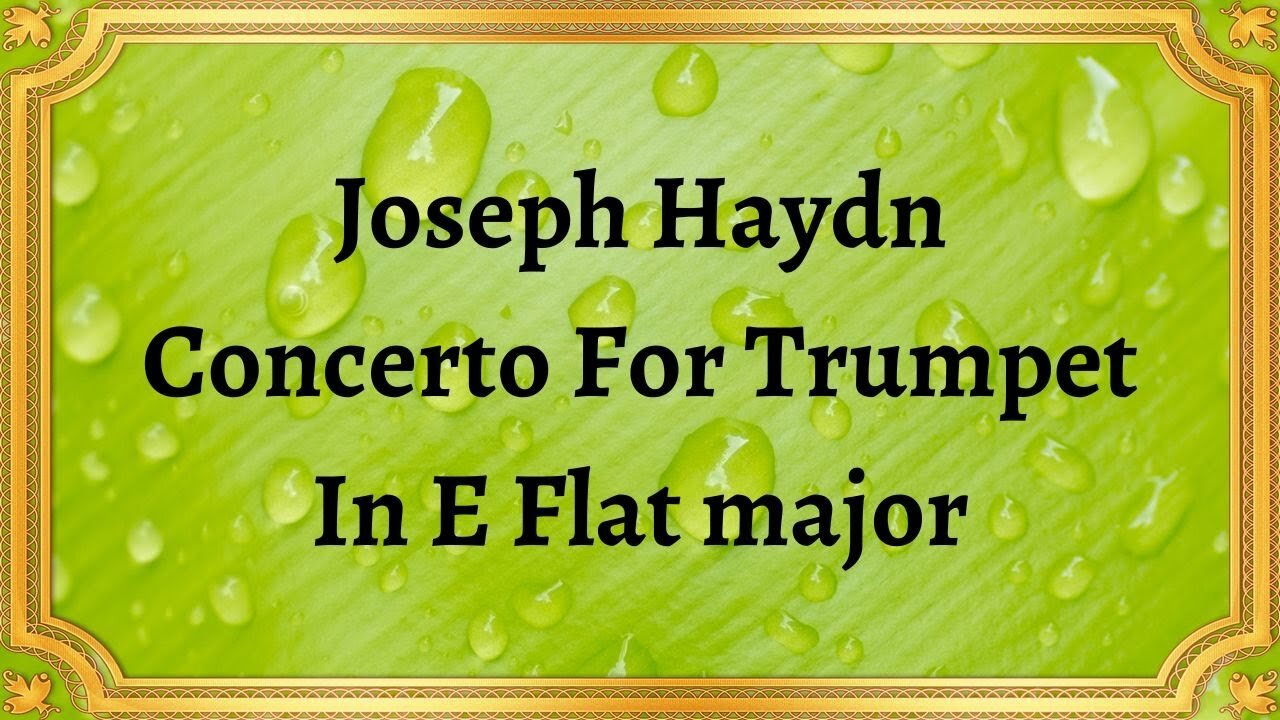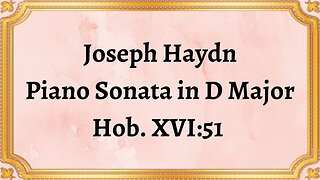Premium Only Content

Joseph Haydn Concerto For Trumpet In E Flat major
#JosephHaydn #trumpetconcerto #Eflatmajor #classicalmusic #musicalcomposition #Austriancomposer #trumpetrepertoire #virtuosictrumpetwriting #orchestralaccompaniment #classicalperiod #soloist #melodicpassages #technicalchallenges #musicalexpressiveness #musicperformance #musicappreciation #composer #musictheory
Publication date 1951
VIENNA STATE OPERA
Helmut Wobitsch, Trumpet
The "Concerto for Trumpet in E Flat major" by Joseph Haydn is a significant and beloved piece in the classical music repertoire. Composed during the classical period, this concerto showcases the brilliance of Haydn as a composer and his ability to highlight the trumpet as a solo instrument within an orchestral setting.
Joseph Haydn, an Austrian composer, composed this concerto in the late 18th century. It is often hailed as one of the most important works in the trumpet repertoire due to its virtuosic trumpet writing and its innovative approach to showcasing the instrument's capabilities.
The concerto consists of three movements: Allegro, Andante, and Finale. In the first movement, the Allegro, Haydn introduces the solo trumpet with a majestic and heroic fanfare. The soloist navigates through various melodic passages, demonstrating technical prowess and control. The orchestra provides a rich and supportive accompaniment, creating a harmonious dialogue between the soloist and the ensemble.
The second movement, the Andante, offers a contrasting mood to the lively Allegro. It begins with a lyrical and expressive melody played by the solo trumpet. Haydn's masterful use of dynamics and phrasing evokes a sense of emotional depth and introspection. The orchestra provides a delicate and tender backdrop, enhancing the soloist's melodic lines. This movement showcases the trumpet's ability to convey beauty and sensitivity.
The concerto reaches its exciting conclusion with the energetic and spirited Finale. The soloist demonstrates technical agility and virtuosity through rapid passages and thrilling runs. Haydn's playful and lively composition creates a sense of joy and celebration. The orchestra provides a lively and dynamic accompaniment, culminating in a triumphant finale that leaves a lasting impact on the listener.
The "Concerto for Trumpet in E Flat major" is renowned for its technical challenges and demands on the soloist. It requires exceptional skill, precision, and control from the trumpet player, making it a favorite among accomplished trumpet performers. The concerto also showcases Haydn's ability to balance the soloist's virtuosity with the orchestral accompaniment, creating a harmonious and balanced musical experience.
Beyond its technical aspects, the concerto also highlights Haydn's musical expressiveness and his ability to create captivating melodies and harmonies. It exemplifies the classical period's emphasis on structure, clarity, and elegance while showcasing the trumpet as a solo instrument capable of conveying a wide range of emotions.
The "Concerto for Trumpet in E Flat major" by Joseph Haydn is a masterpiece that continues to captivate audiences and trumpet enthusiasts alike. Its combination of technical brilliance, melodic beauty, and orchestral accompaniment make it a cherished and frequently performed work in the classical music repertoire.
In conclusion, Joseph Haydn's "Concerto for Trumpet in E Flat major" is a significant musical composition that showcases the trumpet as a solo instrument within an orchestral context. Its virtuosic trumpet writing, expressive melodies, and dynamic orchestration make it a standout piece in the classical music canon. This concerto serves as a testament to Haydn's compositional genius and his ability to create music that resonates with audiences through its technical challenges and musical depth.
You have the opportunity to support the channel https://destream.net/live/RadSiarAl/donate
-
 6:07
6:07
Classical music_Music Inspiration
1 month agoJoseph Haydn Piano Sonata in D Major, Hob. XVI:51
901 -
 2:52:01
2:52:01
Jewels Jones Live ®
2 days agoTRUMP SECURES BORDER | A Political Rendezvous - Ep. 113
42.5K24 -
 25:02
25:02
marcushouse
20 hours ago $35.68 earnedStarship Just Exploded 💥 What Went Wrong This Time?!
110K54 -
 12:00
12:00
Silver Dragons
1 day agoBullion Dealer Reveals Best Silver to Buy With $1,000
65.4K9 -
 12:58
12:58
NinjaGamblers
11 hours ago $12.35 earnedIs This The BEST Way to Win At Roulette? 😲
102K13 -
 1:01:54
1:01:54
CharLee Simons Presents Do Not Talk
2 days agoCALIFORNIA'S DONE!
68.2K29 -
 7:33
7:33
MudandMunitions
1 day agoUnboxing My FIRST Revolver! Smith & Wesson 442 .38 Special and What’s Coming Next for the Channel
93K12 -
 1:01:05
1:01:05
Trumpet Daily
1 day ago $10.65 earnedGermany Started Two World Wars and Now Wants Nuclear Weapons - Trumpet Daily | Mar. 7, 2025
76.5K84 -
 57:07
57:07
Stephen Gardner
1 day ago🚨BREAKING: Musk STUNS even Trump with LATEST FRAUD DISCOVERY!!
203K459 -
 2:26:47
2:26:47
FreshandFit
21 hours agoRatchet Chick Gets Kicked Out "Gracefully" For THIS...
195K202